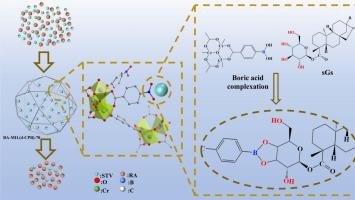Construction of a boric acid-functionalized MOF via metal-ligand-fragment coassembly for Stevia glycoside separation
IF 9.8
1区 农林科学
Q1 CHEMISTRY, APPLIED
引用次数: 0
Abstract
Rebaudioside A is a promising natural sweetener, but its separation from steviol glycoside (sGs) mixtures remains challenging. The rational design of crystalline porous adsorbents with abundant specific binding sites presents a promising solution. A boronic acid-functionalized metal-organic framework (BA-MIL) was synthesized via metal-ligand-fragment co-assembly (MLFC) strategy, using terephthalic acid as the parent ligand and incorporating ligands (p-phenylenediboronic acid, 4-carboxyphenylboronic acid, 3-carboxyphenylboronic acid and 4-formylphenylboronic acid). By adjusting the type and proportion of these fragment ligands, the pore size and the density of boronic acid groups in the adsorbent were accurately controlled. Results demonstrated that BA-MIL(4-CPB)-70 featured a 2.60 nm pore size, high surface area (1360 m2/g), and dense boronic acid groups. By combining molecular sieving and boronate affinity, BA-MIL(4-CPB)-70 efficiently separated stevioside and Rebaudioside A. When applied to a crude sGs extract, it achieved high adsorption capacities (QSTV = 145.2 mg/g, QRA = 126.1 mg/g), selectivity (3.04), and excellent recyclability.

金属-配体-片段共聚构建硼酸功能化甜叶菊糖苷分离MOF
雷鲍迪糖苷A是一种很有前途的天然甜味剂,但从甜菊糖苷混合物中分离雷鲍迪糖苷仍然具有挑战性。合理设计具有丰富特异结合位点的晶体多孔吸附剂是一种很有前途的解决方案。以对苯二甲酸为母体配体,结合对苯二硼酸、4-羧基苯基硼酸、3-羧基苯基硼酸和4-甲酰苯基硼酸等配体,采用金属-配体-片段共组装(MLFC)策略合成了硼酸功能化金属-有机骨架(BA-MIL)。通过调整这些片段配体的类型和比例,可以精确控制吸附剂中硼酸基团的孔径和密度。结果表明,BA-MIL(4-CPB)-70具有孔径2.60 nm,高表面积(1360 m2/g)和致密的硼酸基团的特点。BA-MIL(4-CPB)-70通过分子筛分和硼酸亲和相结合,有效分离了甜菊糖苷和rebaudio苷a。应用于sGs粗提物,具有较高的吸附量(QSTV = 145.2 mg/g, QRA = 126.1 mg/g)、选择性(3.04)和优良的可回收性。
本文章由计算机程序翻译,如有差异,请以英文原文为准。
求助全文
约1分钟内获得全文
求助全文
来源期刊

Food Chemistry
工程技术-食品科技
CiteScore
16.30
自引率
10.20%
发文量
3130
审稿时长
122 days
期刊介绍:
Food Chemistry publishes original research papers dealing with the advancement of the chemistry and biochemistry of foods or the analytical methods/ approach used. All papers should focus on the novelty of the research carried out.
 求助内容:
求助内容: 应助结果提醒方式:
应助结果提醒方式:


